Angelfish and Betta Fish are favorites for many in home freshwater tanks. But is it possible for them to share one aquarium?
What do you need to think about if you want to house them both? How about how the tank is arranged, the kind of water they need, and the way they eat?
I’m going to go over all this and more in this article, so you end up knowing everything essential. Let’s dive in.
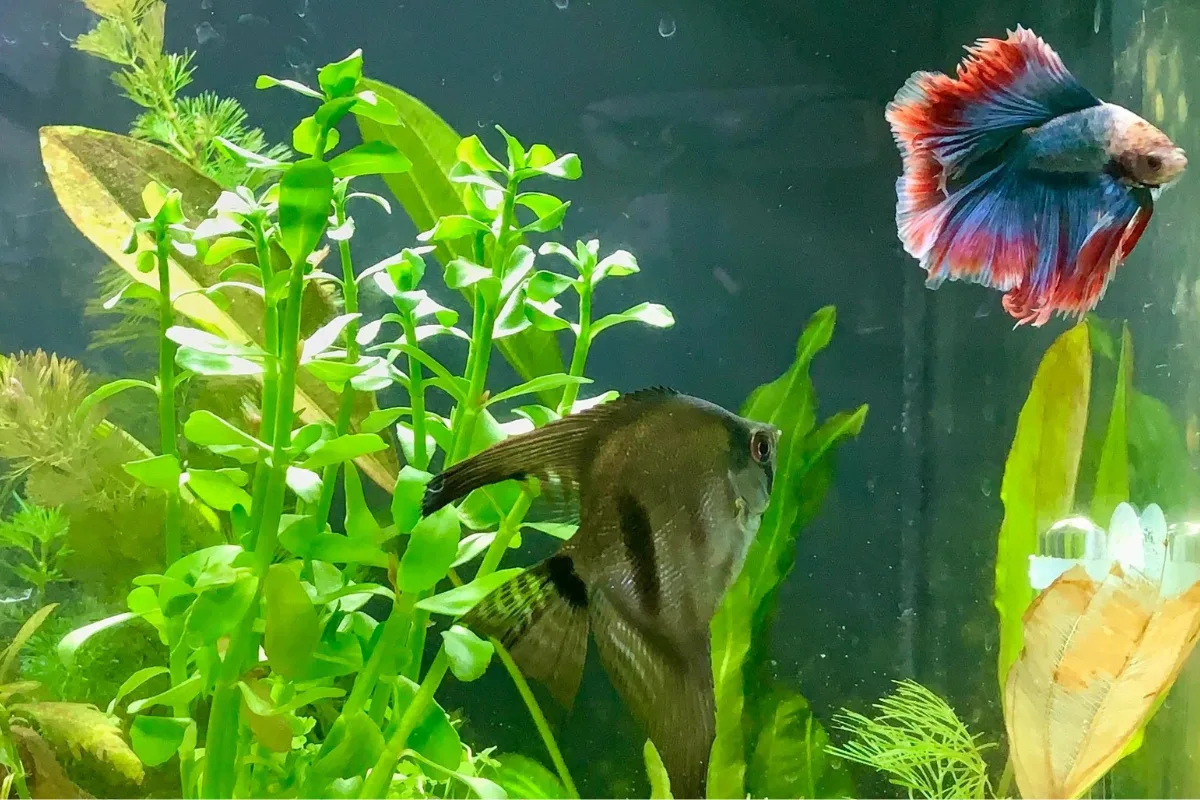
Can I Keep Angelfish and Betta Fish Together in the Same Tank?
No, it’s generally not advisable to keep Angelfish and Betta fish together in the same tank.
The two species have different needs and behaviors that can lead to conflict and stress when housed in the same environment.
- Incompatibility in Behavior: Angelfish are semi-aggressive and can become especially territorial during breeding times, which could lead to them harassing or attacking the more docile Betta fish.
- Temperament Clashes: Angelfish can be territorial and may perceive the long fins of Betta fish as a threat, leading to potential aggression and stress.
- Differing Water Conditions: Angelfish thrive in slightly acidic to neutral water (pH 6.8-7.8), whereas Betta fish prefer a more acidic environment (pH 6.5-7.0), making ideal conditions challenging to maintain.
- Dietary Differences: While both are omnivores, Angelfish need a varied diet including more live foods which might not suit the Betta’s requirements or feeding schedule.
- Fin Nipping Tendency: Angelfish have a tendency to nip fins, and the flowing fins of a Betta present an irresistible target, which can lead to injury or infection.
- Space Requirements: Angelfish require a larger tank (minimum 20 gallons) due to their size and swimming behavior, whereas Bettas can become stressed in too large of a space.
Also Read: Angelfish Tank Mates
Angelfish vs. Betta Fish: Behavior
The first factor worth considering is the Angelfish’s and the Betta fish’s natural behavior. Here is what you should know:
Angelfish: Natural Behavior
Angelfish are inherently social and interactive but have a strong territorial instinct that can make them aggressive, particularly when they feel their area is encroached upon.
In an aquarium, these behaviors are pronounced when competing for food, mates, or territory.
- Establishing Dominance: Angelfish frequently assert dominance within a group, chasing away competitors and showcasing aggressive postures.
- Territorial Displays: These fish often claim areas around tank features, like plants or rocks, and will defend these vigorously against other fish.
- Reaction to Breeding: During breeding, Angelfish become exceptionally protective, often resulting in heightened aggression towards tank mates.
- Interaction with Environment: Angelfish show intelligence by engaging with their surroundings, recognizing caretakers, and examining new objects in the tank.
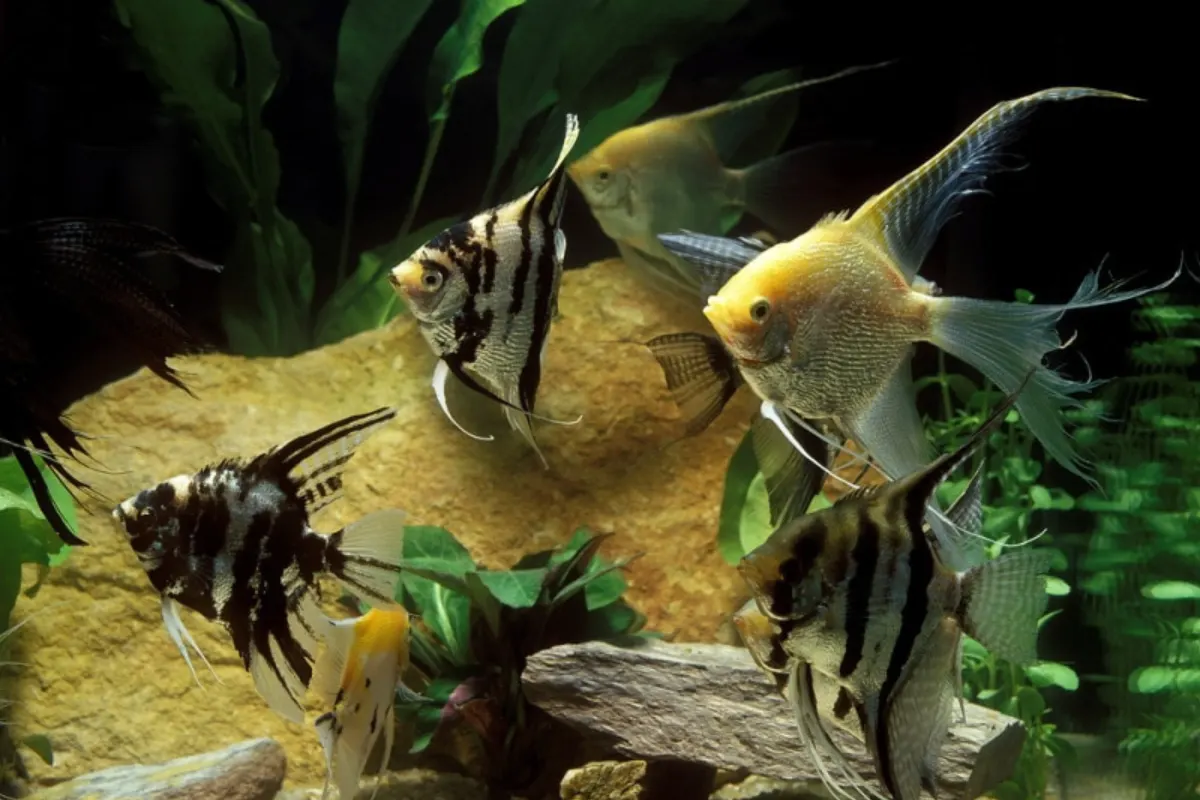
Betta Fish: Natural Behavior
Betta fish, especially males, are known for their solitary and aggressive nature, requiring space and specific conditions to flourish.
Their behavior is shaped by a natural inclination to defend their territory, often leading to aggression if they feel threatened.
- Lone Survivors: Bettas thrive in solitary environments, where they can claim territory without the need for competition.
- Aggressive Displays: Male Bettas display their large, colorful fins to intimidate rivals and establish control over their space.
- Bubble Nest Building: Bettas construct bubble nests for breeding and are fiercely protective of these, often becoming aggressive if disturbed.
- Selective Companionship: While Betta fish can coexist with other species, they prefer tank mates that are less colorful and less likely to encroach on their territory.
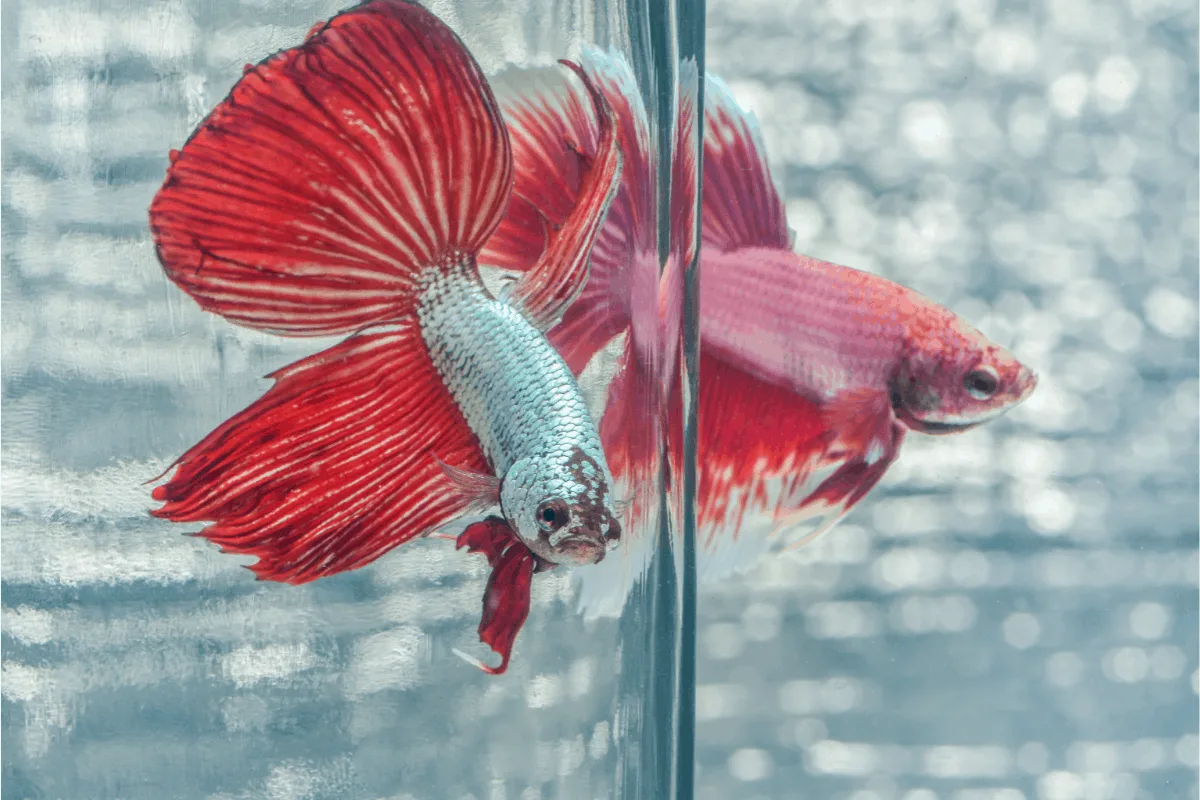
Ideal Parameters for Angelfish and Betta Fish
This table outlines the ideal water parameters for both Angelfish and Betta Fish. The ‘Both Types’ column suggests a compromise for keeping both in the same tank.
| Parameter | Angelfish | Betta Fish | Both Types |
| Temperature | 76°F – 84°F (24°C – 29°C) | 78°F – 80°F (25.5°C – 26.5°C) | 78°F – 80°F (25.5°C – 26.5°C) |
| pH Level | 6.8 – 7.8 | 6.5 – 7.0 | 6.8 – 7.0 |
| Water Hardness | 3 – 8 dGH | 3 – 5 dGH | 3 – 5 dGH |
Angelfish: Ideal Parameters
Angelfish require specific water conditions to thrive, with a preference for warm, slightly acidic to neutral water that mimics their Amazonian river basin origins.
Maintaining these parameters is crucial for their immune system, growth, and overall well-being.
- Optimal Temperature: Angelfish need warm water, with an ideal temperature range of 76°F to 84°F (24°C to 29°C) to stay healthy.
- pH Level: The ideal pH level for Angelfish is slightly acidic to neutral, ranging from 6.8 to 7.8, which helps in mimicking their natural habitat.
- Water Hardness: Soft to moderately hard water, around 3 to 8 dGH, is best for Angelfish, aligning with the soft waters of the Amazon.
Also Read: Can Angelfish And African Dwarf Frogs Live Together?
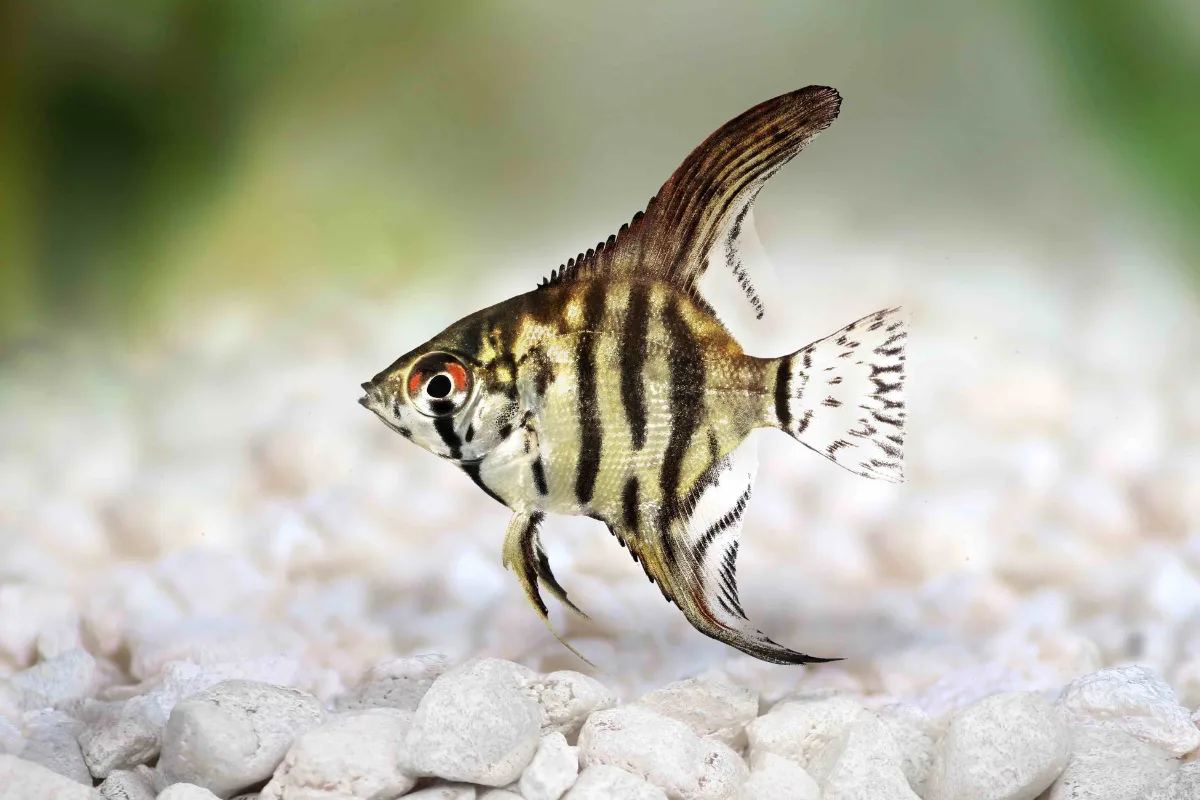
Betta Fish: Ideal Parameters
Betta fish come from warm, acidic waters in Southeast Asia and prefer a stable environment that supports their labyrinth organ functionality, which allows them to breathe atmospheric air.
They are less tolerant of fluctuating conditions, emphasizing the importance of consistent water quality.
- Optimal Temperature: Betta fish thrive in temperatures between 78°F to 80°F (25.5°C to 26.5°C), crucial for proper metabolism and immune function.
- pH Level: A slightly acidic pH of 6.5 to 7.0 is preferred by Betta fish, resembling the pH of their native rice paddies and slow-moving streams.
- Water Hardness: Betta fish do best in soft to moderately hard water, ideally between 3 and 5 dGH, which aids in maintaining their mucous membranes.
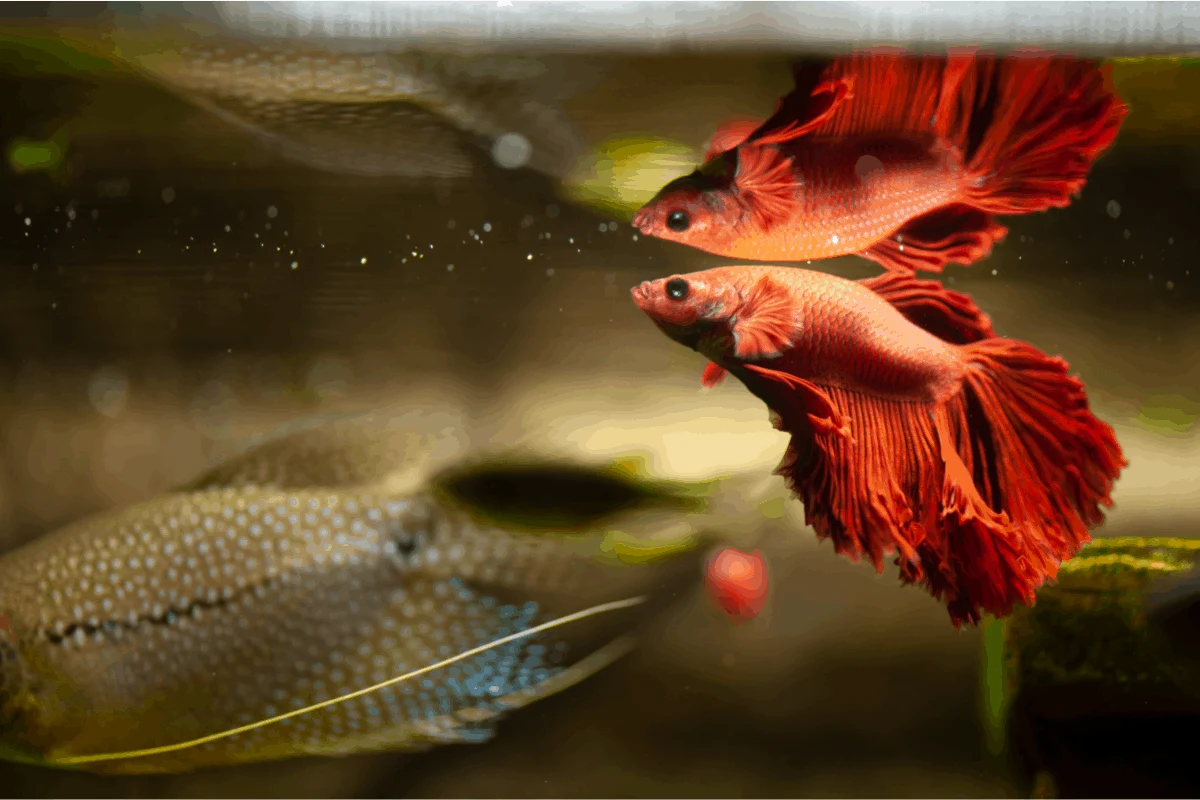
Angelfish vs. Betta Fish: Tank Setup
The table compares the elements required in a tank setup for Angelfish and Betta fish, providing an adjusted setup for a tank containing both.
| Tank Setup Component | Angelfish | Betta Fish | Both Types |
| Tank Size | Minimum 20 gallons | 5-10 gallons | Minimum 55 gallons |
| Filtration | Powerful, 4-5x tank volume/hr | Gentle flow | Moderate, adaptable flow rate |
| Substrate | Fine to medium grain | Smooth | Fine to medium, smooth-edged |
| Decorations | Plants and caves | Soft plants, smooth decorations | Varied plants and decorations |
| Lighting | Moderate | Soft, subdued | Moderate, with shaded areas |
| Heater | Stable heater needed | Stable heater needed | Stable heater needed |
| Water Quality | Ammonia 0, Nitrite 0, Nitrate <20 ppm | Ammonia 0, Nitrite 0, Nitrate <20 ppm | Ammonia 0, Nitrite 0, Nitrate <20 ppm |
| Foliage | Live or silk plants | Soft-leaved plants | Mixture of both types |
| Pump | Optional | Gentle or no air pump | Gentle air pump |
Angelfish: Tank Setup
Angelfish require a spacious and carefully maintained tank to replicate their natural habitat and support their active swimming behavior.
A balance of clean water, ample space, and an environment that offers both hiding places and open swimming areas is essential for their well-being.
- Ammonia/Nitrite/Nitrate: Angelfish need a tank with ammonia and nitrite at 0 ppm; nitrates should be kept low, under 20 ppm, to prevent stress.
- Tank Size: A minimum of 20 gallons is required for a single Angelfish, with an additional 10 gallons for each added fish to ensure adequate space.
- Foliage: Live or silk plants are essential for Angelfish, providing hiding spaces and contributing to the tank’s ecological balance.
- Decorations: Angelfish appreciate various decorations that create hiding spots but also require open areas for swimming.
- Filter: A high-quality filter that can process 4-5 times the tank volume per hour is ideal for maintaining clean water for Angelfish.
- Heater: Angelfish tanks need a reliable heater to maintain a stable temperature within their preferred range.
- Substrate: A fine to medium-grained substrate is best for Angelfish, which allows for foraging and can anchor plants.
- Pump: An air pump is not strictly necessary for Angelfish but can aid in water circulation and oxygenation.
- Lighting: Moderate lighting that mimics a natural day cycle is preferable for Angelfish, avoiding excessively bright lights.
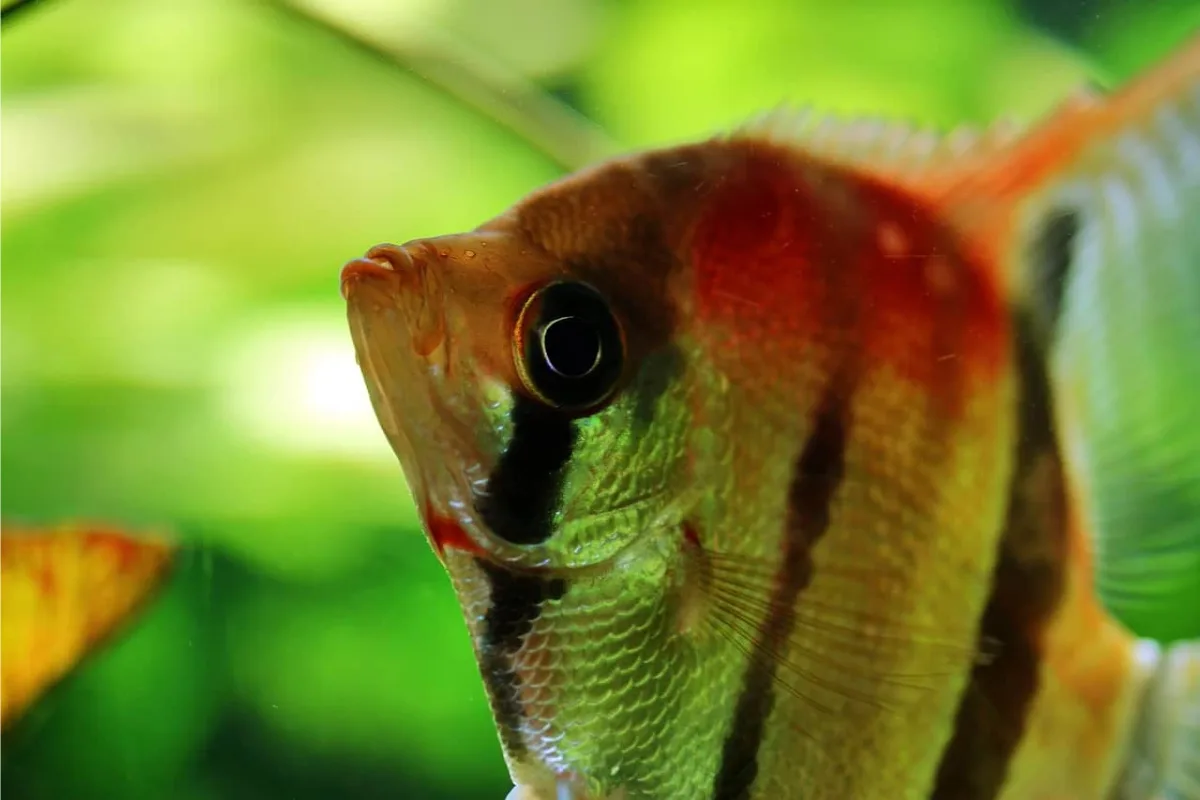
Betta Fish: Tank Setup
Betta fish do not demand as much space as Angelfish but require a stable and serene environment, as they are prone to stress from overstimulation and poor water conditions.
Their tanks should be tailored to provide warmth and gentle water flow, respecting their need for calm and clean water.
- Ammonia/Nitrite/Nitrate: Betta fish are sensitive to ammonia and nitrite, which should always be at 0 ppm, and nitrates kept below 20 ppm to avoid poisoning and stress.
- Tank Size: A 5-gallon tank is the minimum size for a Betta to ensure enough space for exercise and stress reduction.
- Foliage: Betta fish benefit from soft-leaved plants that provide shelter and a sense of security, live plants also help with water quality.
- Decorations: Smooth-edged decorations and caves offer the Betta hiding places without risking fin damage.
- Filter: A filter with a gentle flow is necessary for Betta tanks to keep water clean while not creating strong currents they dislike.
- Heater: Bettas require a steady temperature and need a heater capable of maintaining the water between 78°F and 80°F.
- Substrate: Smooth substrate is recommended for Bettas to prevent fin tearing and to support live plants if used.
- Pump: Air pumps should be used with caution; a gentle flow is needed as Betta fish prefer still water.
- Lighting: Soft, subdued lighting is best for Betta fish, avoiding the bright, direct light that can cause stress.
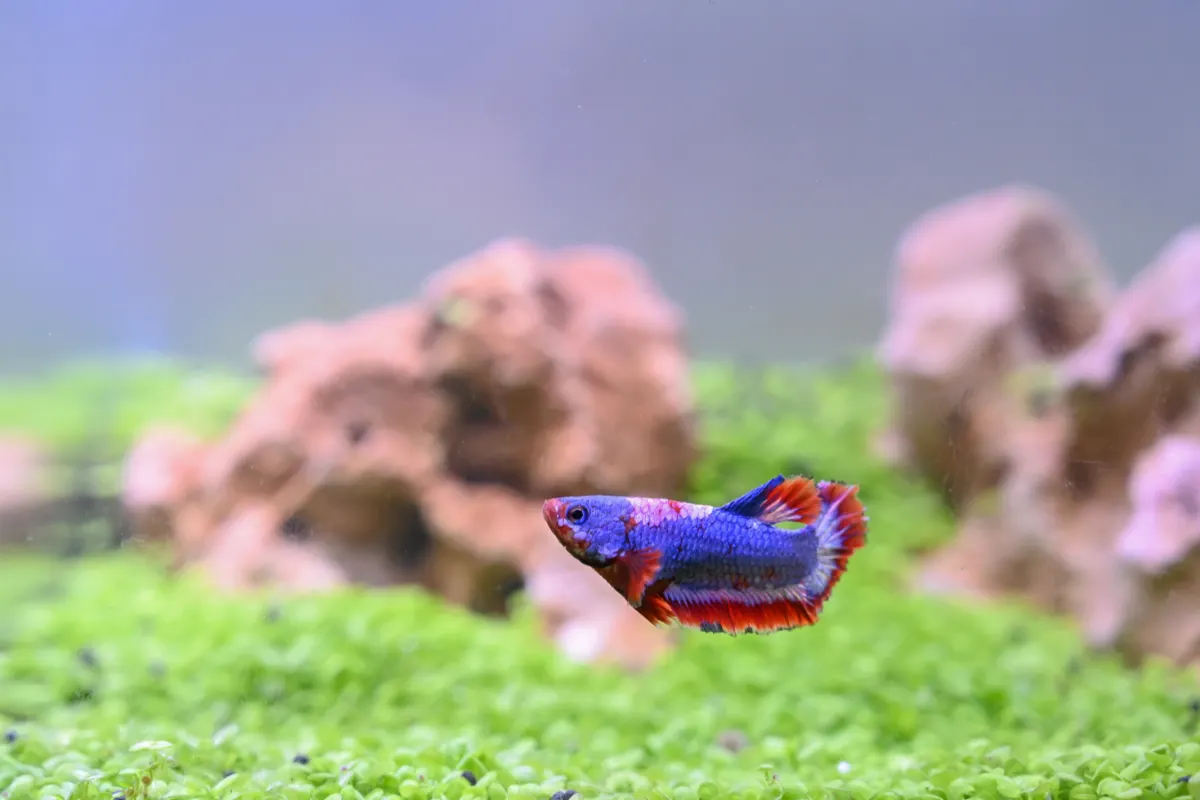
The Dietary Requirements of Angelfish and Betta Fish
This table provides a quick reference to the dietary needs of Angelfish and Betta Fish, along with suggestions for a tank that includes both.
| Dietary Requirements | Angelfish | Betta Fish | Both Types |
| Food Types | Flakes, pellets, live foods | Betta pellets, live insects | Variety of flakes, pellets, and live foods |
| Quantity | Enough for 1 min feeding, 2-3 times/day | Small quantities, 1-2 times/day | Adjusted for each, prevent overfeeding |
| Feeding Schedule | Consistent daily times | Once or twice a day, with one fasting day | Consistent times, separate areas |
Angelfish: Ideal Dietary Requirements
Angelfish are omnivorous and require a varied diet rich in proteins and vitamins to support their growth and vibrant coloration.
They benefit from a mix of high-quality flake foods, live or frozen foods, and vegetable matter to meet their nutritional needs.
- Food Types: Angelfish thrive on a diet that includes flakes, pellets, frozen or live bloodworms, brine shrimp, and blanched vegetables like spinach.
- Quantity: It’s crucial to feed adult Angelfish two to three times a day with enough food that they can consume within a minute to prevent overfeeding.
- Feeding Schedule: Consistency is key; feeding Angelfish at the same times each day helps maintain their health and reduces stress.
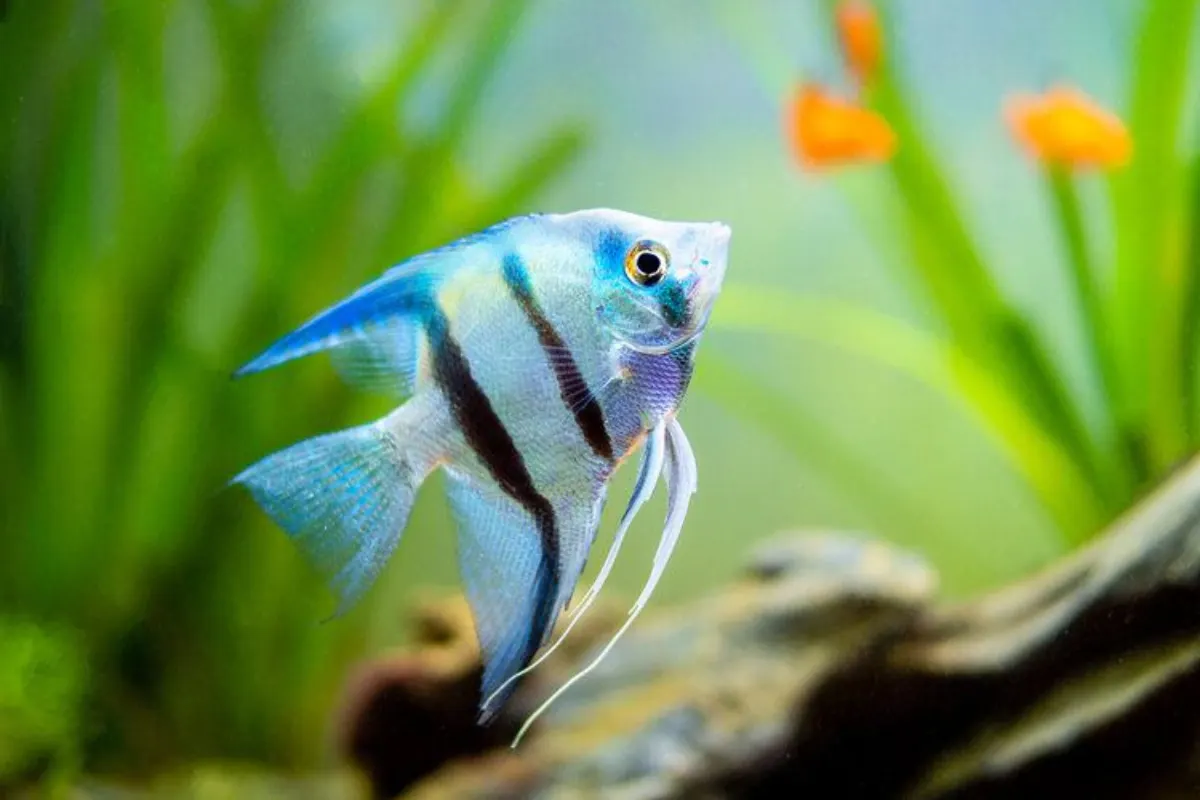
Betta Fish: Ideal Dietary Requirements
Betta fish are primarily carnivorous and have a diet in the wild that consists mostly of insects and larvae.
In captivity, they require high-protein foods and should be fed carefully to avoid overfeeding, which can lead to health issues.
- Food Types: A Betta’s diet should consist of specialized Betta pellets, daphnia, bloodworms, and occasionally brine shrimp as a treat.
- Quantity: Betta fish should be fed once or twice a day with the amount they can eat in about two minutes; overfeeding can lead to obesity and water quality issues.
- Feeding Schedule: Bettas benefit from a regular feeding schedule, and incorporating a fasting day each week can help prevent digestive problems.
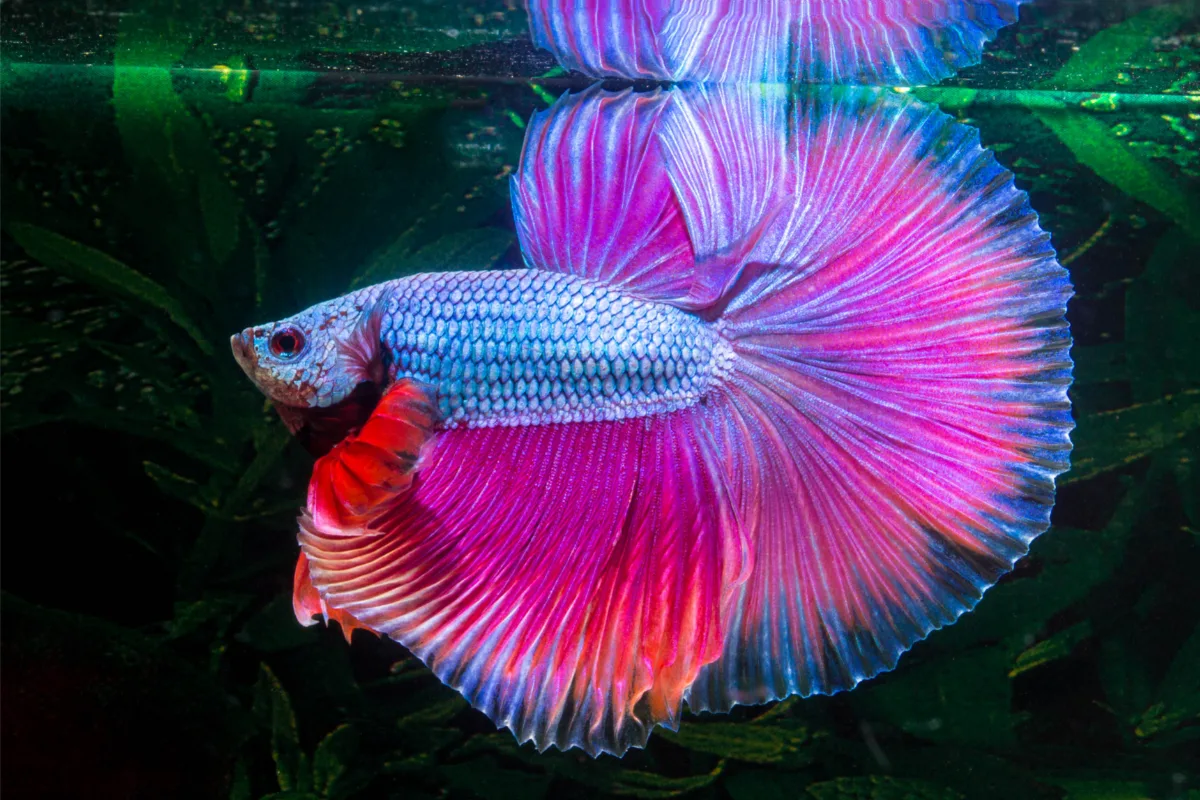
Tips for Keeping Angelfish with Betta Fish
While not recommended, if an aquarist attempts to house Angelfish with Betta fish, they must be vigilant and proactive to minimize risks of aggression.
- Spacious Tank: Opt for a tank of at least 55 gallons to give Angelfish and Betta enough room, reducing territorial behavior and stress.
- Sight Breaks: Install tall plants like Amazon swords and multiple decorations to create barriers and private niches for each fish.
- Separate Feeding Areas: Feed Angelfish on one side and Betta on the other, perhaps using a tank divider during feeding times to avoid conflict.
- Close Monitoring: Observe daily, looking for torn fins or changes in behavior, which are signs of conflict that need immediate attention.
- Water Quality: Maintain pristine water conditions, with 0 ppm ammonia and nitrites, and nitrates under 20 ppm, to reduce stress-related aggression.
- Harmonious Selection: Choose the most docile Betta specimen and Angelfish that have a history of peaceful behavior towards other tank mates.
- Quick Intervention: Have a secondary tank ready for immediate separation if aggressive interactions persist, to ensure the safety of all fish involved.
Also Read: Can Angelfish And Guppies Live Together?
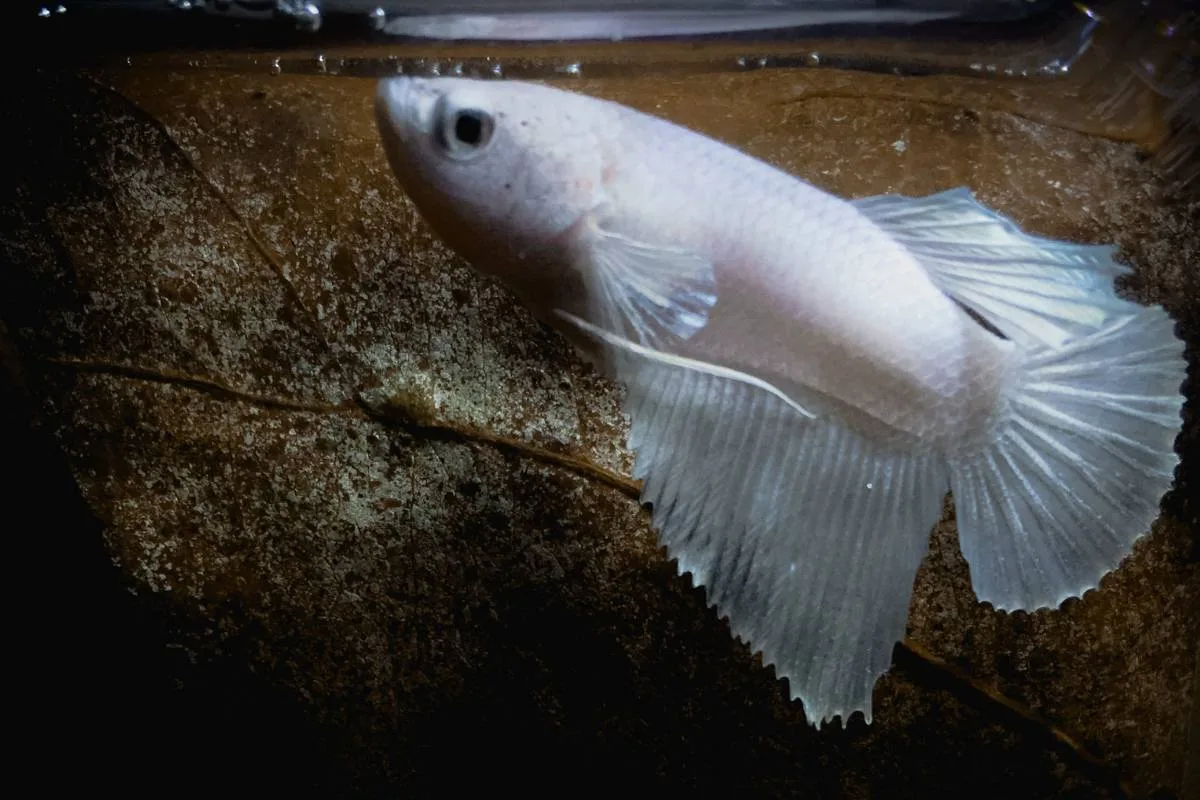
How to Introduce Your Angelfish to a Tank with Betta Fish
Introducing Angelfish to a tank with Betta fish requires a careful and gradual approach to reduce the risk of aggressive behavior.
It’s important to monitor the interaction closely and have a contingency plan in case the introduction does not go smoothly.
- Quarantine Period: Keep the Angelfish in a separate quarantine tank for at least 2 weeks to monitor health and prevent disease transmission to the Betta.
- Tank Adjustment: Gradually adjust the Angelfish to the tank’s water parameters over several hours using the drip acclimation method to minimize shock.
- Visual Introduction: Use a tank divider or place the Angelfish in a clear, floating acclimation box inside the tank to allow visual contact with the Betta without physical interaction.
- Observe Interactions: After full introduction, observe their behavior closely for a few days, looking for signs of stress or aggression from either fish, ready to separate if needed.
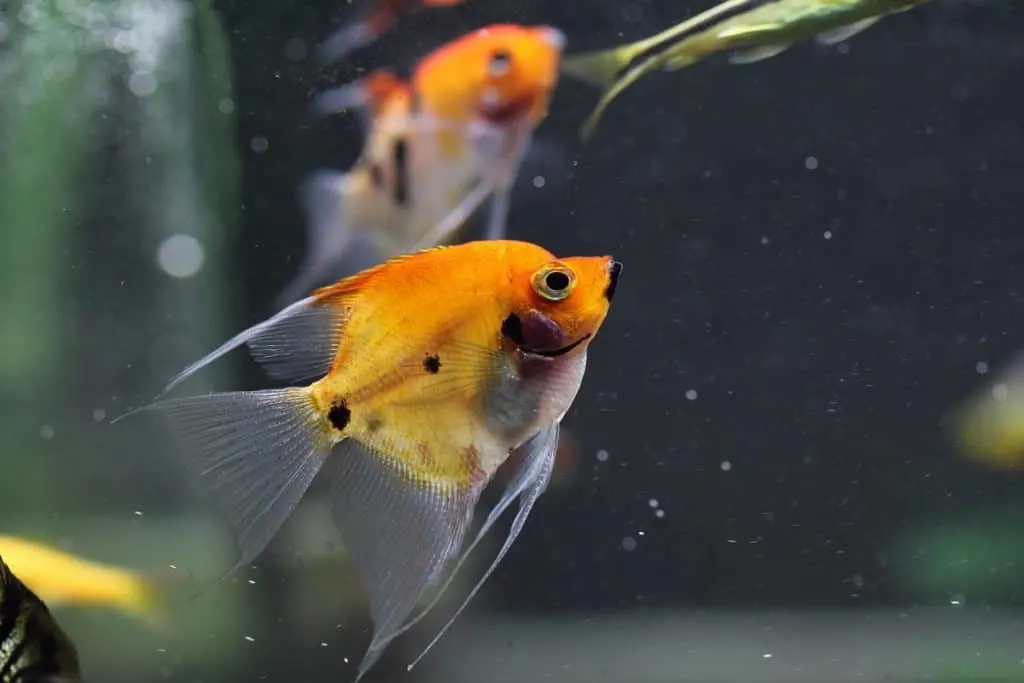
Should I Choose an Angelfish or a Betta Fish
Choosing between an Angelfish and a Betta fish largely depends on your tank size, your experience level, and the kind of interaction you want with your fish.
Angelfish are best for larger, community tanks, while Bettas suit smaller, species-specific setups.
- Tank Size Consideration: If you have a larger aquarium (20 gallons or more), Angelfish are a suitable choice; for smaller tanks (5-10 gallons), a Betta is ideal.
- Social Preferences: Angelfish are social and do well in groups, whereas Bettas are solitary and can thrive alone, which might be simpler for a beginner.
- Care Level: Angelfish require more complex care and stable water conditions, making them better for intermediate aquarists; Bettas are hardier and easier for beginners.
- Interaction Level: If you’re seeking more interactive pets, Angelfish are known to recognize their owners, while Bettas may provide less interaction but have striking appearances.
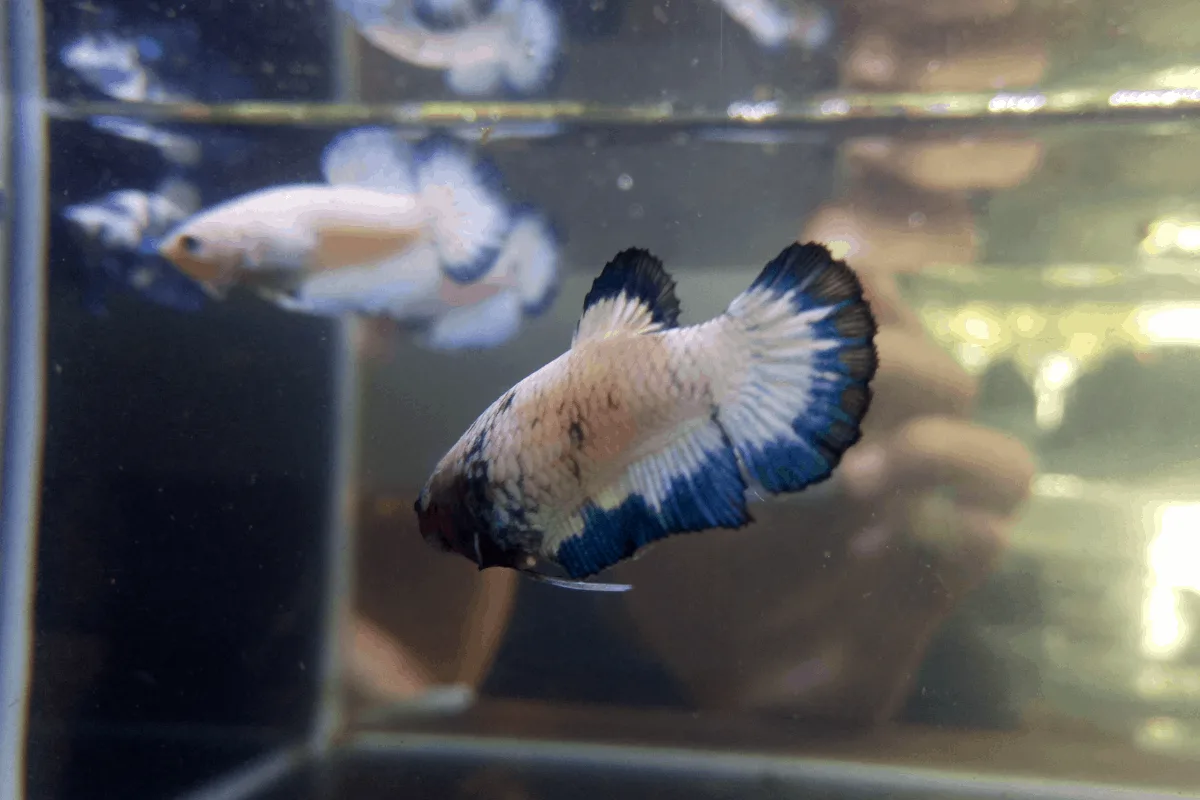
Conclusions
For quick readers, here’s a short summary:
- Angelfish and Betta fish generally do not make good tank mates due to different social behaviors, territorial needs, and environmental requirements.
- While Angelfish are social and can be aggressive, particularly around breeding, Betta fish are solitary and may become stressed or aggressive in shared spaces.
- Ideal water conditions for each species differ, with Angelfish requiring a slightly acidic to neutral environment, and Betta fish needing more acidic conditions, making shared water parameters challenging.
- Tank requirements for both fish vary significantly; Angelfish need spacious tanks with specific setups, while Bettas need smaller, calmer environments.
- Dietary needs also differ, with Angelfish requiring a varied diet including live food, while Betta fish need a high-protein diet with controlled feeding to prevent overfeeding.
